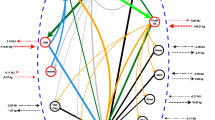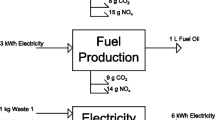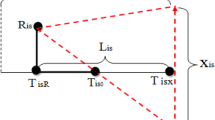Abstract
Purpose
The matrix method for the solution of the so-called inventory problem in LCA generally determines the inventory vector related to a specific system of processes by solving a system of linear equations. The paper proposes a new approach to deal with systems characterized by a rectangular (and thus non-invertible) coefficients matrix. The approach, based on the application of regression techniques, allows solving the system without using computational expedients such as the allocation procedure.
Methods
The regression techniques used in the paper are (besides the ordinary least squares, OLS) total least squares (TLS) and data least squares (DLS). In this paper, the authors present the application of TLS and DLS to a case study related to the production of bricks, showing the differences between the results accomplished by the traditional matrix approach and those obtained with these techniques. The system boundaries were chosen such that the resulting technology matrix was not too big and thus easy to display, but at the same time complex enough to provide a valid demonstrative example for analyzing the results of the application of the above-described techniques.
Results and discussion
The results obtained for the case study taken into consideration showed an obvious but not overwhelming difference between the inventory vectors obtained by using the least-squares techniques and those obtained with the solutions based upon allocation. The inventory vectors obtained with the DLS and TLS techniques are closer to those obtained with the physical rather than with the economic allocation. However, this finding most probably cannot be generalized to every inventory problem.
Conclusions
Since the solution of the inventory problem in life cycle inventory (LCI) is not a standard forecasting problem because the real solution (the real inventory vector related to the investigated functional unit) is unknown, we are not able to compute a proper performance indicator for the implemented algorithms. However, considering that the obtained least squares solutions are unique and their differences from the traditional solutions are not overwhelming, this methodology is worthy of further investigation.
Recommendations
In order to make TLS and DLS techniques a valuable alternative to the traditional allocation procedures, there is a need to optimize them for the very particular systems that commonly occur in LCI, i.e., systems with sparse coefficients matrices and a vector of constants whose entries are almost always all null but one. This optimization is crucial for their applicability in the LCI context.



Similar content being viewed by others
References
Ardente F, Beccali M, Cellura M (2004) F.A.L.C.A.D.E.: a fuzzy software for the energy and environmental balances of products. Ecol Model 176(3–4):359–379
Azapagic A, Clift R (1999) Allocation of environmental burdens in multiple-function systems. J of Clean Prod 7:101–119
Beghelli S, Guidorzi RP, Soverini U (1987) Structural identification of multivariable systems by the eigenvector method. Int J Control 46:671–678
Blunier B, Pucci M, Cirrincione G, Cirrincione M, Miraoui A (2008) A scroll compressor with a high-performance sensorless induction motor drive for the air management of a PEMFC system for automotive applications. IEEE Trans Veh Technol 57(6):3413–3427
Cirrincione M, Pucci M, Cirrincione G, Capolino GA (2003) A new experimental application of least-squares techniques for the estimation of the induction motor parameters. IEEE Trans Ind Appl 39(5):1247–1256
Cirrincione M, Pucci M, Cirrincione G, Capolino GA (2006) An adaptive speed observer based on a new total least-squares neuron for induction machine drives. IEEE Trans Ind Appl 42(1):89–104
Cirrincione M, Pucci M, Cirrincione G, Capolino GA (2007) Sensorless control of induction machines by a new neural algorithm: The TLS EXIN neuron. IEEE Trans Ind Electron 54(1):127–149
De Moor B (1990) Total least squares with inequality constraints. ESAT-SISTA Report 1990-02, Department of Electrical Engrg., Katholieke Universiteit Leuven, Leuven, Belgium
DeGroat RD, Dowling EM (1993) The data least squares problem and channel equalization. IEEE Trans Signal Process 41(1):407–411
Dobson AJ (1983) Introduction to statistical modelling. Chapman and Hall, London
Dunne BE, Williamson GA (2003) QR-based TLS and mixed LS–TLS algorithms with applications to adaptive IIR filtering. IEEE Trans Signal Process 51(2):386–394
Ekvall T (1994) Principles for allocation at multi-output processes and cascade recycling. In: Huppes G, Schneider F (eds) Proc. of the European Workshop on Allocation in LCA, Leiden, February 1994. SETAC-Europe, Brussels, pp 91–101
Fisher GW (1989) Matrix analysis of metamorphic mineral assemblages and reactions. Contrib Mineralogy Petrol 102:69–77
Golub GH, Van Loan CF (1980) An analysis of the total least squares problem. SIAM J Numer Anal 17:883–893
Golub GH, van Loan CF (1989) Matrix computations. John Hopkins University Press, 2nd ed., 1989
Guinée JB, Heijungs R, Huppes G (2004) Economic allocation: examples and derived decision tree. Int J Life Cycle Assess 9(1):23–33
Hall HR, Bernhard RJ (1989) Total least squares solutions to acoustic boundary element models, In Proc. Internat. Symposium on Numerical Techniques in Acoustic Radiation, ASME Winter Annual Meeting, San Francisco, CA,1989, R.J. Bernhard and R.F. Keltie (eds.), American Society of Mechanical Engineers, New York, 1989, NCA (6):145-152
Harville DA (1997) Matrix algebra from a statistician’s perspective. Springer, New York
Heijungs R (1994) The problem of allocation: some more complications. In: Huppes G, Schneider F (eds) Allocation in LCA. SETAC-Europe, Brussels, pp 8–12
Heijungs R, Frischknecht R (1998) A special view on the nature of the allocation problem. Int J Life Cycle Assess 3(5):321–332
Heijungs R, Suh S (2002) The computational structure of life cycle assessment. Kluwer Academic Publishers, Dordrecht. Series: Eco-Efficiency in Industry and Science, vol. 11
Heintz B, Baisnee PF (1992) System boundaries. In: Life cycle assessment, SETAC-Europe, Brussels, pp 35–52
International Standard ISO 14044 (2006) Environmental management—life cycle assessment—requirements and guidelines
Jakubek S, Hametner C, Keuth N (2008) Total least squares in fuzzy system identification: an application to an industrial engine. Eng Appl Artif Intell 21:1277–1288
Justice JH, Vassiliou AA (1990) Diffraction termography for geophysical monitoring of hydrocarbon reservoirs. Proc IEEE 78:711–722
Klöpffer W, Rebitzer G (2000) A report on LCA activities at the SETAC—Third World Congress, 21–25 May 2000 in Brighton UK. Int J Life Cycle Assess 5:249
Levin MJ (1964) Estimation of a system pulse transfer function in the presence of noise. IEEE Trans Autom Control 9:229–235
Li C, Yu J (2008) Volterra-TLS method for chaotic time series prediction. In: International Conference on Communications, Circuits and Systems. Fujian, China, 25-27 May, pp 48-51
Lim JS (2008) Recursive DLS solution for extreme learning machine-based channel equalizer. Neurocomputing 71:592–599
Marković D, Jukić D (2010) On nonlinear weighted total least squares parameter estimation problem for the three-parameter Weibull density. Appl Math Model 34:1839–1848
Markovsky I, Van Huffel S (2007) Overview of total least squares methods. Signal Process 87(10):2283–2302
Mendel JM (1987) Lessons in digital estimation theory. Prentice-Hall, Englewood Cliffs, USA
Moonen M, Vandewalle J (1990) A QSVD approach to on- and off-line state-space identification. Int J Control 51:1133–1146
Moonen M, De Moor B, Vanderberghe L, Vandewalle J (1989) On- and off-line identification of linear state-space models. Int J Control 49:219–232
Paige CC, Strakos Z (2002) Unifying least squares, total least squares and data least squares. In: Van Huffel S, Lemmerling P (eds) Total least squares and errors-in-variables modeling. Kluwer Academic Publishers, Dordrecht, pp 25–34
Penrose R (1956) On best approximate solution of linear matrix equations. Proc Camb Philos Soc 52:17–19
Rahman MA, Yu KB (1987) Total least squares approach for frequency estimation using linear prediction. IEEE Trans Acoust Speech Signal Process 35:1440–1454, ASSP
Ramos JA (2007) Applications of TLS and related methods in the environmental sciences. Comput Stat Data Anal 52:1234–1267
Rao BD (1997) Unified treatment of LS, TLS and truncated SVD methods using a weighted TLS framework. In: Van Huffel S (ed) Recent advances in total least squares techniques and errors-in-variables modelling. SIAM Publications, Philadelphia, pp 11–20
Rost RW, Leuridan J (1985) A Comparison of least squares and total least squares for multiple input estimation of frequency response functions, ASME Paper Number 85-DET-105, presented at the ASME Design Engineering Division Conference and Exhibit on Mechanical Vibration and Noise, Cincinnati, OH
Roy R, Kailath T (1987) Total least-squares ESPRIT, Proc. 21st Ann. Asilomar Conf. On Signals, Systems and Computers, Pacific Grove, CA, pp 297-301
Roy R, Kailath T (1989) ESPRIT—estimation of signal parameters via rotational invariance techniques. IEEE Trans Speech Signal Process 37(7):984–995
Silvia MT, Tacker EC (1982) Regularization of Marchenko's integral equation by total least squares. J Acoust Soc Am 72:1202–1207
Stewart GW, Sun J (1990) Matrix perturbation theory. Academic Press, Inc., Boston
Stoian A, Stoica P, Van Huffel S (1990) Comparative performance study of least-squares and total least squares Yule-Walker estimates of autoregressive parameters. Scientific Bulletin, Electrical Eng Series, Polytechnic Institute of Bucharest 52(2):81–89
Swindlehurst AL, Ottersten B, Roy R, Kailath T (1992) Multiple invariant ESPRIT. IEEE Trans Signal Process 40(4):867–881
Tillman AM, Ekvall T, Baumann H, Rydberg T (1994) Choice of system boundaries in life cycle assessment. J Clean Prod 2(1):21–29
Van Huffel S (1987) Analysis of the total least squares problem and its use in parameter estimation. Doctoral dissertation, Dept. of Electr. Eng., Katholieke Universiteit Leuven
Van Huffel S, Vandewalle J (1988) Analysis and solution of the nongeneric total least squares problem. SIAM J Matrix Anal Appl 9:360–372
Van Huffel S, Vandewalle J (1989) Algebraic connections between the least squares and total least squares problems. Numer Math 55:431–449
Van Huffel S, Vandewalle J (1991) The total least squares problems: computational aspects and analysis. Frontiers in Applied Mathematics, SIAM Philadelphia
Van Huffel S, Vandewalle J, De Roo MC, Willems JL (1987) Reliable and efficient deconvolution technique based on total linear least squares for calculating the renal retention function. Med Biol Eng Comput 25:23–33
Zoltowski MD (1987) Signal processing applications of the method of total least squares with applications to array processing, In Proc. 21st Asilomar Conf. On Signals, Systems and Computers, Pacific Grove, CA, pp 290-296
Zoltowski MD (1988) Generalized minimum norm and constrained total least squares with applications to array processing, In Proc. SPIE, Advanced Algorithms and Architectures for Signal Processing, III, San Diego, CA 975:78-85
Zoltowski MD, Stavrinides D (1989) Sensor array signal processing via a Procrustes rotations based eigenanalysis of the ESPRIT data pencil. IEEE Trans Acoustic Speech Signal Process 37:832–861, ASSP
Acknowledgment
This work has been carried out with support from (1) the GENIUS LOCI project titled “The role of the building sector on climate change”, funded by the Italian Ministries of Economy; Education; University and Research, Environment and Territory protection, Agricultural and Forestry policies; (2) the Teaching Staff mobility funds in the framework of the LLP/Erasmus program, under the Erasmus Bilateral Agreement in force between the University of Palermo and the University of Leiden.
Author information
Authors and Affiliations
Corresponding author
Additional information
Responsible editor: Andreas Ciroth
Electronic supplementary materials
Below is the link to the electronic supplementary material.
Appendix
(PDF 67 kb)
Rights and permissions
About this article
Cite this article
Marvuglia, A., Cellura, M. & Heijungs, R. Toward a solution of allocation in life cycle inventories: the use of least-squares techniques. Int J Life Cycle Assess 15, 1020–1040 (2010). https://doi.org/10.1007/s11367-010-0214-1
Received:
Accepted:
Published:
Issue Date:
DOI: https://doi.org/10.1007/s11367-010-0214-1




